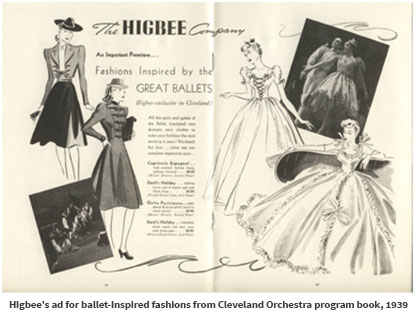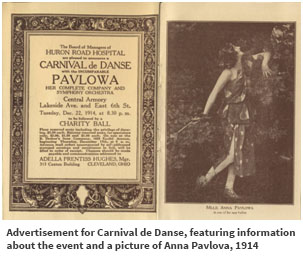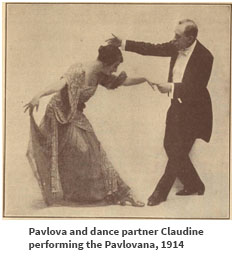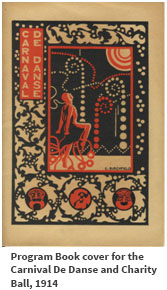
Dancing Through Time
The Cleveland Orchestra and Ballet
By Kate Rogers
A rare opportunity to witness the collaboration of two world-class performing forces is upon us in Northeast Ohio: The Joffrey Ballet will visit Cleveland once again in November 2014 to perform Tchaikovsky's The Nutcracker with The Cleveland Orchestra. Their acclaimed performance of the ballet in the 2012-13 season, as well as their recreation of Stravinsky’s The Rite of Spring two summers ago at Blossom, has given Cleveland audiences the opportunity to experience ballet performed by a premier company to live music by The Cleveland Orchestra. But has ballet always been a part of the cultural life of Northeast Ohio? When did ballet first become popular here, and who made it happen? Throughout its hundred-year presence in Cleveland, the art of ballet has contributed to war relief efforts, inspired numerous fashion trends, delighted audiences on picnic blankets, and dazzled spectators from the concert stage.
 Ballet found its way to Cleveland through unlikely circumstances in the fall of 1914. World War I had started in July of that year, and Cleveland’s Huron Road Hospital decided to put on a charity event to raise money to aid the Allied Powers (the United Kingdom, France, and the Russian Empire). The Hospital’s board members decided that Adella Prentiss Hughes, Cleveland impresario (who founded The Cleveland Orchestra a few years later), was the perfect woman to plan the event. Hughes envisioned a “Carnival de Danse and Charity Ball,” in which famed Russian ballerina Anna Pavlovaand her company would present a program of divertissements followed by a social dance in which Clevelanders could participate. She quickly got in touch with Pavlova’s manager to book the performance and asked numerous local businesses to donate to the cause or place ads in the program.
Ballet found its way to Cleveland through unlikely circumstances in the fall of 1914. World War I had started in July of that year, and Cleveland’s Huron Road Hospital decided to put on a charity event to raise money to aid the Allied Powers (the United Kingdom, France, and the Russian Empire). The Hospital’s board members decided that Adella Prentiss Hughes, Cleveland impresario (who founded The Cleveland Orchestra a few years later), was the perfect woman to plan the event. Hughes envisioned a “Carnival de Danse and Charity Ball,” in which famed Russian ballerina Anna Pavlovaand her company would present a program of divertissements followed by a social dance in which Clevelanders could participate. She quickly got in touch with Pavlova’s manager to book the performance and asked numerous local businesses to donate to the cause or place ads in the program.
Hughes secured the Central Armory (formerly on Lakeside Avenue and 6th St.) for the event, a venue where the seats surrounded the large dance floor.

After months of planning, the event itself was held in late December 1914 at the height of Cleveland’s midwinter social season, and vacationers flocked back to town just for this fabulous performance. Pavlova and her company danced a number of short ballets on the evening of December 22, many of them performed to Russian music played by a group of musicians under the direction of Theodore Stier, conductor of the London Classic Symphony Orchestra. They also demonstrated a set of modern society dances, which had been requested by social club leaders in New York and other large cities.  Pavlova even presented her own versions of social dances, like the Pavlova Waltz, the Pavlovana, and the New Gavotte Pavlova, offering alternatives to the more standardized versions. But the most exciting part of the event was the second half, which allowed Clevelanders themselves to try out the dance floor — for $5 (a little over $100 today) — anyone could dance right alongside Pavlova and her company for the rest of the night! This novelty was wildly popular, and the dancing continued into the early morning hours. The Carnival de Danse raised over $14,000 (which would be over $300,000 today!) for the Huron Road Hospital’s war relief efforts, and guests from far and wide were treated to a spectacular evening of ballet and social dancing.
Pavlova even presented her own versions of social dances, like the Pavlova Waltz, the Pavlovana, and the New Gavotte Pavlova, offering alternatives to the more standardized versions. But the most exciting part of the event was the second half, which allowed Clevelanders themselves to try out the dance floor — for $5 (a little over $100 today) — anyone could dance right alongside Pavlova and her company for the rest of the night! This novelty was wildly popular, and the dancing continued into the early morning hours. The Carnival de Danse raised over $14,000 (which would be over $300,000 today!) for the Huron Road Hospital’s war relief efforts, and guests from far and wide were treated to a spectacular evening of ballet and social dancing.
 One year after her hugely successful Carnival de Danse and Charity Ball, Hughes once again endeavored to bring ballet to Cleveland. The world-renowned Ballets Russes, a Russian company directed by Serge Diaghilev, planned to stage a tour of the United States in 1916. Hughes made sure that Cleveland would be one of their first stops, and arranged for the company to perform ballets set to music of Stravinsky and Rimsky-Korsakov, among others. Shortly after the arrival of the Ballets Russes in New York, American fashions began to reflect the intricate costumes and scenery seen on stage.
One year after her hugely successful Carnival de Danse and Charity Ball, Hughes once again endeavored to bring ballet to Cleveland. The world-renowned Ballets Russes, a Russian company directed by Serge Diaghilev, planned to stage a tour of the United States in 1916. Hughes made sure that Cleveland would be one of their first stops, and arranged for the company to perform ballets set to music of Stravinsky and Rimsky-Korsakov, among others. Shortly after the arrival of the Ballets Russes in New York, American fashions began to reflect the intricate costumes and scenery seen on stage.
 Leon Bakst, artistic director of the Ballets Russes and preeminent fashion designer, became hugely popular: playwright George Bernard Shaw even stated that “Bakst has furnished the first real inspiration for fashions in women’s dress for many years.” Hughes noticed these trends when she saw the Ballets Russes’s opening performance in New York, and asked prominent New York department stores to ship these ballet-inspired fashions to Cleveland so merchants could sell them in the months leading up to the performances here. It is no surprise, then, that bold colors were all the rage in Clevelandin the form of bags, scarves, dresses, and other fashion accessories during the spring of 1916. The ballet performances were a huge hit, and people came from at least 35 different locations outside of Cleveland to see eleven different ballets performed over four days! Diaghilev himself told Adella Prentiss Hughes that, out of all of the cities that the Ballets Russes visited, “the Cleveland audience had been the most appreciative, the best prepared, and the one which in consequence received the best work of the players.
Leon Bakst, artistic director of the Ballets Russes and preeminent fashion designer, became hugely popular: playwright George Bernard Shaw even stated that “Bakst has furnished the first real inspiration for fashions in women’s dress for many years.” Hughes noticed these trends when she saw the Ballets Russes’s opening performance in New York, and asked prominent New York department stores to ship these ballet-inspired fashions to Cleveland so merchants could sell them in the months leading up to the performances here. It is no surprise, then, that bold colors were all the rage in Clevelandin the form of bags, scarves, dresses, and other fashion accessories during the spring of 1916. The ballet performances were a huge hit, and people came from at least 35 different locations outside of Cleveland to see eleven different ballets performed over four days! Diaghilev himself told Adella Prentiss Hughes that, out of all of the cities that the Ballets Russes visited, “the Cleveland audience had been the most appreciative, the best prepared, and the one which in consequence received the best work of the players.
This 1916 performance was the Ballets Russes’s first and last appearance in Cleveland, though an offshoot company called Ballet Russe of Monte Carlo returned to Northeast Ohio in 1934. In the intervening years, Cleveland audiences experienced a wealth of ballet performances by other touring companies, but this 1934 performance was the first time that The Cleveland Orchestra itself invited a ballet company to Cleveland to collaborate in performance. Once again, ballet took fashion by storm in the weeks surrounding the performances, and numerous women’s fashions inspired by the Ballet Russe de Monte Carlo’s visit were seen all around Cleveland including in pages of the Cleveland Orchestra’s program books!

The Cleveland Orchestra continued to invite the Ballet Russe of Monte Carlo back to Northeast Ohio for the next five seasons to collaborate in performance, establishing a strong ballet tradition in Cleveland by 1940.

When Blossom Music Center opened in 1968, it was not long before outdoor ballet events became popular, and people flocked to the amphitheatre to enjoy performances of music and dance under the summer sky. From 1968 through the 2014 season, The Cleveland Orchestra has performed over 150 complete ballets, collaborating with seventeen different companies, including New York City Ballet, Martha Graham Dance Company, Vienna State Opera Ballet, the Harkness Ballet, Joffrey Ballet, National Ballet, Pennsylvania Ballet, Eric Hawkins Dance Company, San Francisco Ballet, Houston Ballet, Feld Ballet, Baryshnikov and Company, Cleveland School of Dance, Csardas Dance Company, Cuyahoga Valley Youth Ballet, Miami City Ballet, and Verb Ballet.
The Joffrey Ballet first came to Cleveland in the summer of 1972, performing multiple ballets over three days at Blossom Music Center with The Cleveland Orchestra.
Coincidentally, this company is well known for reviving the choreography of Diaghilev’s Ballets Russes, and has danced reconstructed versions of Petrushka, Afternoon of a Faun, and The Spirit of the Rose, three of the ballets that were performed in 1916 by the Ballets Russes in Cleveland! Though one of the Joffrey’s missions has been to reconstruct famous ballets, their own innovative choreography never ceases to surprise, and Robert Joffrey’s version of The Nutcracker is not to be missed. Since Anna Pavlova’s first visit in 1914, ballet has continued to enrich our community and make Cleveland a special place for the arts for over one hundred years. Let us look forward to a hundred more!
All illustrations are from The Cleveland Orchestra Archives unless otherwise noted.
Looking for more?
- The National Gallery of Australia has an amazing online exhibit of Leon Bakst’s costumes from various ballets. Check it out here!
- To see more costumes of the Ballets Russes by other designers, look at this wonderful piece from the blog “Tyranny of Style,” edited by Joe Kucharski (Assistant Professor at Baylor University).
- This article by Susan Dormadry Eisenberg includes more information about the connection between the Joffrey Ballet and the Ballets Russes.
- For more information about Anna Pavlova, including a short clip of her dancing, click here!